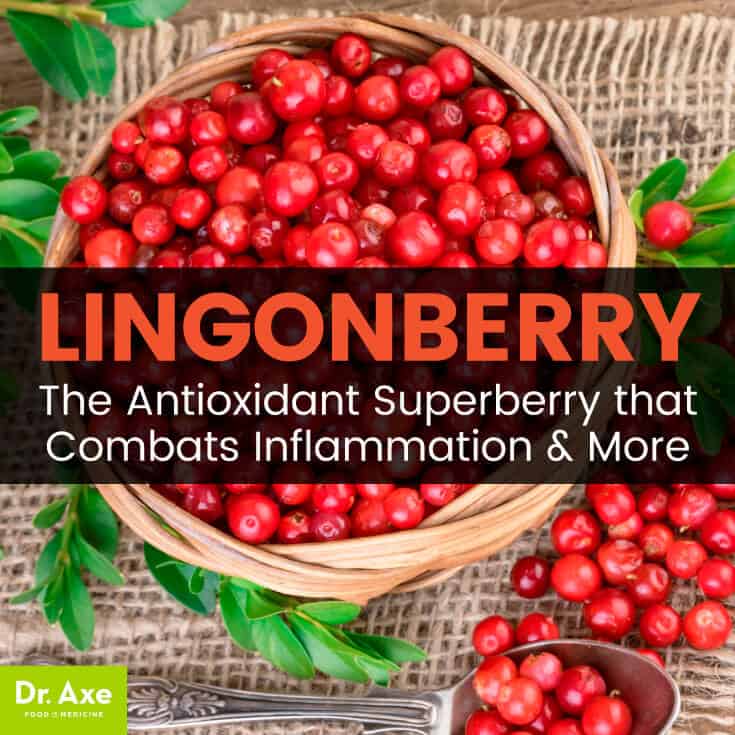
If you’re looking for a superberry, the lingonberry takes the podium since it’s jam-packed with antioxidants and body-enhancing phytonutrients. This small but powerful berry contains numerous medicinal and nutritional benefits. Commonly consumed whole or as lingonberry juice, the quercetin and proanthocyanidin, also found in the cranberry, give it such a positive punch for the body. Similar to the bearberry, lingonberries contain amazing phytochemicals that can do wonders for health.
Lingonberries are popular in various forms and products, such as wines, liqueurs, syrups, lingonberry jams and jellies, cheesecakes, cocktails, soufflés, sherbet, ice cream, candies, and pickles with a taste that’s sour, tart and bit sweet — probably most like the taste of raw cranberries. Containing powerfully rich antioxidants, vitamin A, vitamin C and magnesium, you may see it in cough syrups or as a treatment for blood disorders and urinary tract infections. Additionally, lingonberries are often used in gardens as they make great ground cover.
Benefits of Lingonberry
1. Filled with Antioxidants that Help Prevent Bacterial Infection
According to a study conducted by the Department of Food and Environmental Sciences at the University of Helsinki in Finland, lingonberries may prevent bacterial infection, such as staphylococcal. Staph infections are usually obtained by eating bacteria-infested foods and can happen quite easily as food is handled, shipped, processed, etc. (1)
Lingonberries have been found to contain bacteria-fighting capabilities due to the phenolic, antioxidant, antimicrobial and antiinflammatory characteristics. Similar to the cranberry, they’re composed of proanthocyanidins, anthocyanins, hydroxycinnamic acids, hydroxybenzoic acids and flavonols — all of which are antioxidants that make lingonberries some of the best antioxidant foods.
2. Helps Reduce Inflammation in the Body
Forty healthy men, aged 60, took part in a study on the effects of lingonberries, black currants and bilberries, specifically looking for an increase in quercetin. Twenty of those tested consumed 100 grams per day of berries, including lingonberries, for a period of eight weeks. The other group continued to consume a usual diet.
The results published in the European Journal of Clinical Nutrition showed that those subjects who consumed the berries had a significantly larger amount of quercetin, and since quercetin contains anti-inflammatory properties, it can help anyone dealing with chronic inflammation issues, such as arthritis. (2)
3. May Prevent Cancer Cell Growth
A study published in the Journal of Agricultural and Food Chemistry focused on the effects of the extracts from 10 different fruits and berries, including rosehips, blueberries, black currant, black chokeberries, apple, sea buckthorn, plums, lingonberries, cherries and raspberries. According to the study, the extracts decreased the proliferation of colon cancer cells as well as breast cancer cells. It’s possible that the vitamin C combined with antioxidant-filled anthocyanins may contribute to the inhibition of the growth of cancer cells, so there is potential for berries like lingonberry as cancer-fighting foods. (3)
4. Reduces the Occurrence of Urinary Tract Infections in Women
You’ve probably heard of cranberry juice offering relief for symptoms of urinary tract infection, but the lingonberry may be another great option. Women with urinary tract infection caused by Escherichia coli were randomly allocated into three groups. These women were asked to consume 50 milliliters of cranberry-lingonberry juice concentrate every day for a period of six months, 100 milliliters of lactobacillus drink five days a week for one year, or had no intervention at all.
The study, conducted by the Department of Pediatrics at the University of Oulu in Finland, indicated that there was a 20 percent reduction in the risk of UTI in the berry group as compared with the control group. This tells us that by consuming the juice as part of your regular diet, it may reduce the recurrence of urinary tract infection. (4)
5. Can Help Keep a Healthy Mouth
Bacteria can easily form in the mouth, causing plaque to develop, and if not managed properly this can create bigger problems. The International Journal of Dentistry reported information collected from studies that were conducted to determine the benefits of consuming antimicrobial foods, such as the lingonberry. Results indicate that the antimicrobial characteristics of lingonberries can help reduce the risk of bacteria forming in the mouth.
According to the studies, the accumulation of dental plaque can trigger health problems like gum disease; however, if taken care of on a regular basis through good oral hygiene, you can actually eliminate problems altogether. So how does the lingonberry make a difference? “Bioactive berry compounds are known to cause destabilization of cell membranes of human pathogens causing various antimicrobial effects, for example, depletion of the intracellular ATP pool, inhibition of oxidative phosphorylation, or inhibition of cell wall enzyme activity.” Basically, the antimicrobial effects of lingonberries can inhibit bacterial growth in the mouth. (5)

Lingonberry Nutrition
One cup of raw lingonberries contains about: (6)
- 75 calories
- 6 grams carbohydrates
- 3 grams protein
- 3 grams fat
- 9 grams fiber
- 21.6 milligrams vitamin C (36 percent DV)
- 1,500 IU vitamin A (30 percent DV)
Lingonberry vs. Other Berries
You may be wondering if you should leave your other berries for the amazing benefits of the lingonberry. Variety is always a good thing since different foods provide different benefits — however, the benefits of the lingonberry against the blueberry or the the bilberry, for example, are pretty similar. In fact, the lingonberry is part of the blueberry and cranberry family. Each of these powerful berries contains a ton of disease-fighting antioxidants, making them all a great part of the superberry family. Try them together, make a berry-blend jam or chutney, or top your chia pudding with them. The benefits are amazing and can help give you a healthy, inflammation-free body.
I want to note that a study was found regarding the purchase of capsules that claimed they contained anthocyanins from these berries. The study shows that even though the label indicates contents of lingonberry, blueberry and/or bilberry, among others, analysis delivered different results — ultimately revealing they did not contain the anthocyanins from these berries as claimed. Pay attention to what you purchase and do your research to ensure you are buying what you think you buying. (7)
How to Find, Cook and Use Lingonberry + Lingonberry Recipes
The lingonberry is a member of the blueberry and cranberry plant family, Ericaceae. Specifically known as Vaccinium vitis-idaea, lingonberry goes by a few other names, such as partridgeberry, foxberry, cowberry, northern mountain cranberry, wolf-berry, dry ground cranberry, rock cranberry, tyttebaer (Scandinavia) and ling.
According to studies based out of Cornell University, there are wild and American lingonberries, along with the European lingonberry. The American or wild lingonberry typically produces one crop per year in the summer, while the European version produces two and ranges from two to 16 inches in height with branches three to four inches long.
The previous year’s growth is pretty important since that’s where the lingonberry gets its flower for the new growth. The flowers, usually white or pink, are not unlike the shape and size of blueberry flowers. The lingonberries themselves are typically about ¼- to ½-inch in diameter and bright to dark red. These are quite tasty, giving a good bit of flavor that may be similar to cranberries but not quite as tart. They’re loaded with benzoic acid, which helps them last about eight to 12 weeks in the refrigerator. (8)
The Swedish have the freshest of lingonberries, but they may be hard to come by if you’re not near Scandinavia. However, fresh frozen berries are available and may be the way to go. Check with your local specialty food store or farmer’s market. They may have them readily available or can order them for you.
What Is Lingonberry Jam and How Do You Make It?
Lingonberry jam is pretty simple. Historically, lingonberries originated in the forested areas of the Swedish inland, which is where the making of lingonberry jam became popular. The best lingonberry jam is usually prepared using berries, sugar and a little water, though some are made using pectin. Simply mixing it fresh, without boiling, gives claim to being the finest and is known as raw-stirred lingonberries. However, I prefer the original method, which is without any sugar, substituting honey instead. And since there’s a good bit of benzoic acid with the berries, they’re able to keep well.
Lingonberry Mint Jam Recipe
INGREDIENTS:
- 2 pound fresh lingonberries (or fresh frozen)
- ¾ to 1 cup of water
- One drop peppermint essential oil or fresh chopped mint sprigs (optional)
- ¼–½ cup of local honey
DIRECTIONS:
- Place lingonberries in a medium pot with the water and bring to a boil. Boil for about 5–8 minutes. Remove any foam from the surface.
- Stir in the honey, add the peppermint and bring to a rapid boil. Allow it to boil for a few more minutes. Remove from heat and let it cool.
- Leaving about ¼ inch at the top, ladle the jam into sterile jars. Cover with the lids and screw on rings just tight enough to the point of tension. Place in a hot water bath, making sure they’re fully submerged, for 10 minutes to allow it to seal.
- Once all the jars have lids and rings, lower them into your canning pot. Make sure the jars are fully submerged, covered with about an inch of water. Allow the water in the pot to boil for 10 minutes.
- Then carefully remove the jars from the pot and allow them to cool. Store in a cool dark place without the rings.
- Once you have opened a jar, make sure to refrigerate.
Here are couple more lingonberry recipes to try:
- Lingonberry Smoothie
- Red Cabbage Salad with Green Apple, Lingonberry Preserves and Toasted Walnuts: For this one, I suggest making my lingonberry mint jam above and replacing the canola oil with ⅛ cup sesame oil.
Lingonberry Precautions/Side effects
Lingonberry concentrate is likely OK when taken orally as directed; however, it may not safe to use lingonberry leaves for long periods of time. The leaves may cause nausea and vomiting.
Some concern has been noted regarding liver damage due to the bacteria it can kill in urine, but more studies are needed to confirm this. If you’re pregnant or breast-feeding, check with your doctor before trying any new foods.
Final Thoughts on Lingonberry
Lingonberry is a delicious fruit filled with antioxidants that can help stave off disease and inflammation. Try it in your morning smoothie, as a topping on your favorite pancakes or as a lingonberry sauce on baked turkey breast — the same way you might enjoy cranberries and turkey at Thanksgiving.
By consuming lingonberry, you can help treat UTI, keep your mouth healthy and potentially even prevent cancer cell growth, in addition to staving off other disease. So don’t wait — get lingonberries in your diet and enjoy all these wonderful benefits.
Read Next: Bilberry Improves Eyesight & Decreases Inflammation
From the sound of it, you might think leaky gut only affects the digestive system, but in reality it can affect more. Because Leaky Gut is so common, and such an enigma, I’m offering a free webinar on all things leaky gut. Click here to learn more about the webinar.
